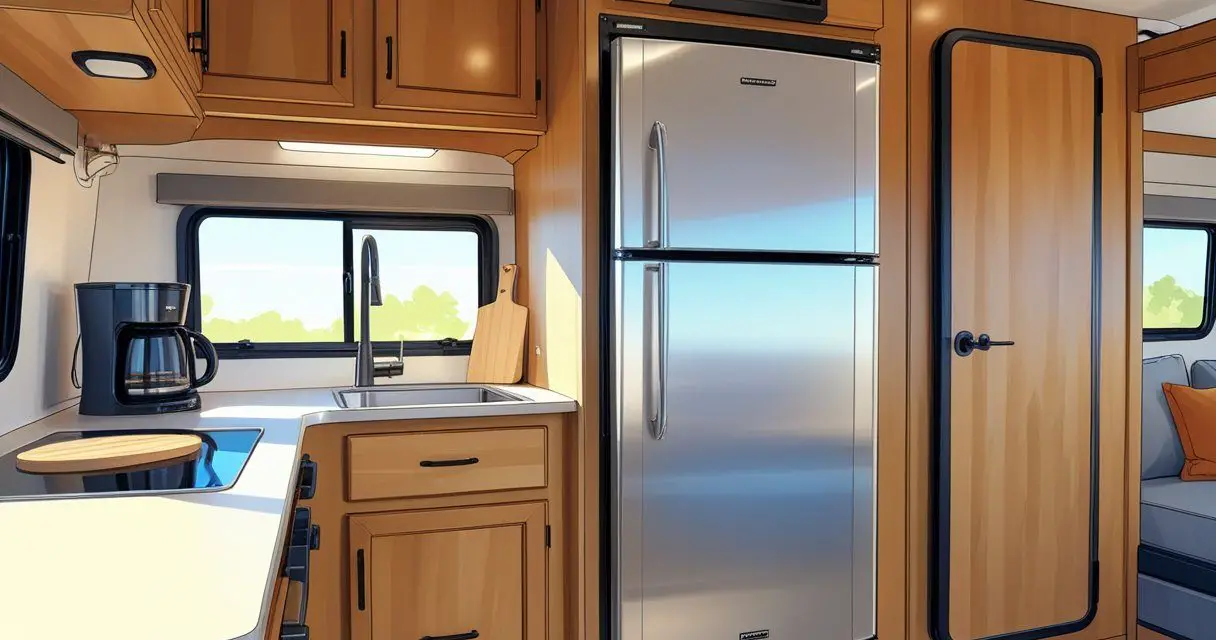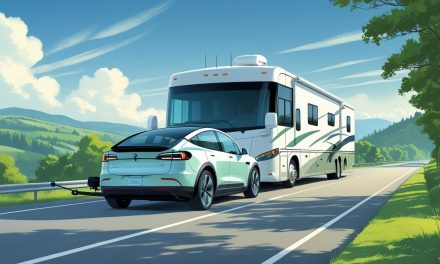Would you like to save this article?
Are you wondering if your RV fridge can be recharged like your car’s air conditioning? Here’s everything you need to know before you waste money on a dangerous scam.
The Short Answer: NO, Your RV Fridge Cannot Be Recharged
Here’s the truth: Most RV refrigerators use something called absorption cooling – and these systems cannot be recharged like your home air conditioner. Anyone telling you they can “recharge” your RV fridge for a few hundred dollars is either misinformed or trying to scam you.
But wait – there’s more to this story that could save you thousands of dollars…
Why RV Fridges Are Different From Home Refrigerators
Two Main Types of RV Refrigerators
| Absorption Fridges | Compressor Fridges |
|---|---|
| Cannot be recharged | Can be recharged (like home fridges) |
| Uses heat to create cooling | Uses compressor and refrigerant |
| Runs on propane, 12V, or 110V | Runs on 12V DC power only |
| No moving parts | Has moving compressor |
| Most common in RVs | Newer, more efficient option |
How Absorption Fridges Work (The Simple Version)
Think of your RV’s absorption fridge like a magical heat-powered cooler:
- It uses a special mix of ammonia, water, and hydrogen gas
- Heat from propane or electricity makes this mixture bubble and flow
- As it flows through special tubes, it gets cold
- Everything is sealed tight – there’s no way to add more mixture
Watch this helpful video to understand how RV refrigeration works:
The “See, Smell, Hear” Test: How to Check Your RV Fridge
Before you panic about replacement costs, do this simple 3-step test that requires no tools:
🔍 STEP 1: SEE
Look for:
- Bright neon liquid pooled anywhere (this is leaked refrigerant)
- Yellow or green powder around the back of the fridge
- Rust or corrosion on the cooling tubes
👃 STEP 2: SMELL
Sniff for:
- Strong ammonia smell (like gym socks or cleaning products)
- Any unusual chemical odors coming from the fridge area
👂 STEP 3: HEAR
Listen for:
- Loud gurgling sounds (like a babbling brook)
- Constant running without getting cold
- Unusual bubbling noises
⚠️ DANGER ALERT: If you detect ANY of these signs, turn off your fridge immediately and call a professional. The leaked chemicals can be dangerous, and hydrogen gas is flammable.
Learn how to perform this test properly:
What These Signs Really Mean
🟡 Yellow Powder = Game Over
That yellow-green powder is sodium chromate – a rust inhibitor that should stay INSIDE your cooling unit. If you see it outside, your cooling unit has a hole and needs replacement.
💨 Ammonia Smell = Expensive Repair
Ammonia leaking out means your sealed system is broken. This cannot be patched or recharged – only replaced.
🔊 Loud Gurgling = Pressure Loss
Normal fridges make quiet percolating sounds. Loud gurgling means gas is escaping and your cooling unit is failing.
Why “Recharging” Is Impossible (And Dangerous)
The Technical Reality
RV absorption fridges are hermetically sealed systems. Unlike car air conditioners, they don’t have:
- ❌ Refill ports to add more refrigerant
- ❌ Accessible valves for service
- ❌ Separate refrigerant tanks
The exact mixture of chemicals must be precise. Even if someone could somehow add more ammonia (they can’t safely), the system would still have the original problem – a leak.
Watch this expert explanation from a mobile RV tech:
The Safety Issue
The chemicals inside include:
- Ammonia (toxic and corrosive)
- Hydrogen gas (explosive – think Hindenburg!)
- Water
- Rust inhibitor
Professional RV techs don’t “recharge” these units for safety reasons – and neither should anyone else.
Your Real Options When Your RV Fridge Fails
Option 1: Replace the Cooling Unit
- Cost: $800-$1,500 (plus labor)
- Good for: Fridges under 10 years old
- Pros: Less expensive than full replacement
- Cons: May not fit if fridge is very old
See how to replace a cooling unit yourself:
Option 2: Replace the Entire Fridge
- Cost: $1,500-$4,000 (plus installation)
- Good for: Old fridges or when cooling unit isn’t available
- Pros: Fresh start with warranty
- Cons: May not fit through your RV door!
💡 MEASURING TIP: Before ordering a new fridge, measure your door opening. Many RVs require removing the windshield or sliding out a slide-out to fit large fridges!
Option 3: Upgrade to Compressor Fridge
- Cost: $1,000-$3,000
- Good for: Full-time RVers or those wanting efficiency
- Pros: More efficient, can be recharged if needed
- Cons: Only runs on 12V, needs more battery power
Learn about 12V compressor fridges:
How to Prevent RV Fridge Failure
The #1 Killer: Running While Unlevel
Never run your absorption fridge when your RV isn’t level! Here’s why:
- Unlevel operation bakes the rust inhibitor
- This blocks tiny tubes in the cooling unit
- Continued use cracks the boiler tubes
- Result: Expensive cooling unit failure
Smart Maintenance Tips
✅ DO:
- Keep your RV level when fridges is running
- Clean exterior vents twice yearly
- Check door seals regularly
- Use fridge fans to improve efficiency
- Pre-cool before trips
❌ DON’T:
- Run fridge while driving on steep hills
- Block exterior venting
- Ignore strange smells or sounds
- Try DIY “recharging” methods
Watch proper RV fridge maintenance techniques:
Learn some cooling hacks:
Troubleshooting Your RV Fridge
Before assuming your cooling unit has failed, try these troubleshooting steps:
Watch this comprehensive troubleshooting guide:
For a quick 5-minute diagnosis:
Maintenance Schedule for RV Fridges
| Frequency | Task | Why It Matters |
|---|---|---|
| Monthly | Check door seals | Prevents cold air loss |
| Quarterly | Clean exterior vents | Improves cooling efficiency |
| Annually | Professional inspection | Catches problems early |
| Before storage | Deep clean and prop open | Prevents mold and odors |
When to Call a Professional
Call immediately if you notice:
- Any ammonia smell
- Yellow powder anywhere
- Loud gurgling sounds
- Complete cooling failure
- Visible liquid leaks
Don’t call if someone offers to:
- “Recharge” your absorption fridge
- “Top off” the refrigerant
- Fix it for under $500 (probably too good to be true)
Red Flags: Avoiding RV Fridge Scams
Common Scam Lines:
- “I can recharge your absorption fridge for $300”
- “Just needs more refrigerant, easy fix”
- “This special tool lets me refill sealed systems”
- “Temporary fix until you can afford replacement”
What Honest Techs Say:
- “Your cooling unit has failed and needs replacement”
- “Absorption fridges can’t be recharged safely”
- “Let’s look at replacement options”
- “Here’s why this happened and how to prevent it”
Cost Breakdown: What to Really Expect
Cooling Unit Replacement
- Parts: $600-$1,200
- Labor: $200-$500
- Total Time: 4-8 hours
- Warranty: Usually 1-2 years
Complete Fridge Replacement
- New Fridge: $1,200-$3,500
- Installation: $300-$800
- Modifications: $0-$1,000 (if needed)
- Total Time: 1-2 days
Real-World Examples: What Cooling Unit Failure Looks Like
See actual cooling unit failure:
Professional cooling unit replacement:
Frequently Asked Questions
Q: Can I just ignore the problem?
A: No! Leaked ammonia will damage your RV’s interior and create health hazards. Address cooling unit failures quickly.
Q: Will insurance cover RV fridge replacement?
A: Usually not, unless it’s damaged by a covered event (like an accident). Normal wear and failure aren’t typically covered.
Q: Can I upgrade to a residential fridge?
A: Maybe, but you’ll need to consider power requirements, space, and weight. Most need constant 110V power.
Q: How long do RV fridges typically last?
A: With proper care, 10-15 years is normal. Poor maintenance (especially running unlevel) can kill them in 3-5 years.
Q: Are there temporary solutions?
A: Portable 12V coolers or small compressor fridges can work temporarily, but plan for permanent replacement soon.
The Bottom Line
Your RV absorption fridge cannot be recharged – anyone claiming otherwise is misinformed or dishonest. When your cooling unit fails, you have three real options: replace the cooling unit, replace the entire fridge, or upgrade to a compressor model.
The best strategy? Take care of your current fridge with proper maintenance, always keep your RV level when it’s running, and start saving for eventual replacement. Most absorption fridges last 10-15 years with good care.
Remember: A failed RV fridge isn’t just an inconvenience – it’s a safety issue that requires prompt, professional attention.
Sources
RV Repair Woman – Mobile RV Tech Expert
Pro RV Prineville – RV Refrigerator Troubleshooting
JustAnswer RV Experts – Absorption Refrigerator Q&A
Lippert Components – Absorption vs Compressor Guide
Camping World – RV Refrigerator Basics





